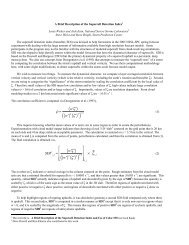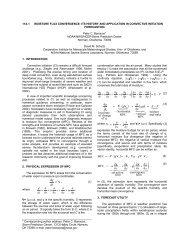Program Overview and Operations Plan - Storm Prediction Center ...
Program Overview and Operations Plan - Storm Prediction Center ...
Program Overview and Operations Plan - Storm Prediction Center ...
Create successful ePaper yourself
Turn your PDF publications into a flip-book with our unique Google optimized e-Paper software.
From ~8:00 am - 9:45 am daily, the forecast team will conduct subjective evaluations related to the<br />
SREF <strong>and</strong> deterministic model components of the program. Web-based forms are provided for<br />
these tasks, which are expected to be done in a collaborative manner with all team members<br />
contributing to the assessments.<br />
A. On Tuesday-Friday during this time period, subjective evaluation of the experimental Day 2<br />
severe weather outlooks valid for the previous day will also be performed. (On Tuesday morning,<br />
the Day 2 experimental outlooks valid for Friday will be evaluated). The evaluation of these<br />
outlooks will utilize plots of severe storm reports overlayed on the forecast probabilities to assess the<br />
accuracy <strong>and</strong> usefulness of the forecasts. It is important to make sure the team members assess the<br />
two outlooks (Preliminary <strong>and</strong> Final) using the following criteria: how well they delineated regions<br />
where severe reports occurred (spatial accuracy), how well they exhibited a sense of reliability (more<br />
reports occurred in regions with higher probabilities), <strong>and</strong> comparing the two outlooks in a relative<br />
sense, e.g., did the update provide better, worse, or the same level of accuracy. The verification will<br />
include numerical ratings from 0-10 <strong>and</strong> an opportunity for a brief written discussion explaining the<br />
decision. More information about the Day 2 Outlook verification forms is found in Attachment D.<br />
Objective verification of the Day 2 outlooks will also be conducted, <strong>and</strong> we view these two methods<br />
as being complementary.<br />
B. Every day, 12z deterministic model forecasts of precipitation areas valid the previous afternoon<br />
will be assessed. Subjective evaluation of the deterministic model precipitation forecasts will focus<br />
on the regional domain used by the 3 km WRF model. This domain is adjusted daily to focus on the<br />
area having the greatest severe potential based on the 13z SPC Day 1 severe outlook. Verification<br />
will be made by comparing 3-hourly accumulated precipitation produced by four high resolution<br />
models (Eta12, EtaKF20, NMM8, WRF12, <strong>and</strong> WRF3) with hourly mosaic images of radar base<br />
reflectivity. The intent is not to perform a QPF verification, because storm severity is not necessarily<br />
correlated with precipitation amounts. What we are most interested in is the ability of the model<br />
precipitation forecasts to provide useful guidance to severe weather forecasters interested in<br />
predicting the Awhere@, the Awhen@, <strong>and</strong> the spatial pattern of thunderstorm development. Our<br />
working concept is this: if we have a good idea how the timing, location, <strong>and</strong> evolution of afternoon<br />
convection will unfold, our ability to issue high quality severe weather watches will increase in some<br />
situations. In addition, we will examine more closely comparisons between the WRF12 that<br />
incorporates the K-F convective parameterization scheme <strong>and</strong> the WRF3 with explicit precipitation<br />
physics. Our goal here is twofold: 1) to assess the impact of substantially increased resolution <strong>and</strong><br />
explicit physics in the WRF, <strong>and</strong> 2) to determine if providing higher temporal resolution output<br />
(accumulated model precipitation at 1-hourly time frames compared to the st<strong>and</strong>ard 3-hourly time<br />
frames) assists forecasters in identifying detailed precipitation structures <strong>and</strong> aspects of convective<br />
mode in the model precipitation fields. It has been shown that subjective verification of mesoscale<br />
model precipitation fields provides important information about human perception of model<br />
performance, since traditional measures such as Equitable Threat Score can provide misleading<br />
information when small scale features are considered. See Attachment E for more information<br />
about the model precipitation forecast evaluation forms.<br />
IX. Daily Map Discussion<br />
A daily map discussion is held from 1:00-1:30 pm in the SSA to bring together SPC forecasters <strong>and</strong><br />
7



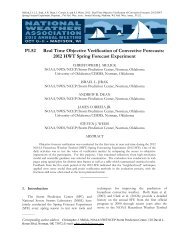
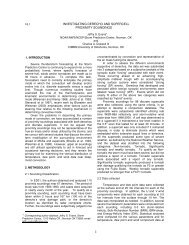
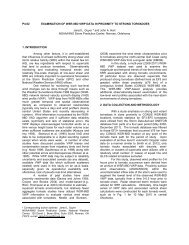
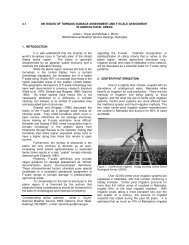
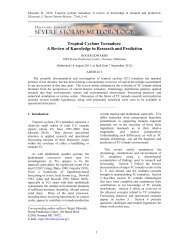


![NSWW_ROC_Overview.ppt [Read-Only] - Storm Prediction Center ...](https://img.yumpu.com/26478320/1/190x146/nsww-roc-overviewppt-read-only-storm-prediction-center-.jpg?quality=85)
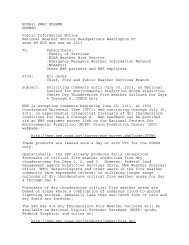
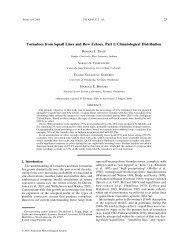

![NEW_PRODUCTS_imy.ppt [Read-Only] - Storm Prediction Center ...](https://img.yumpu.com/26478296/1/190x146/new-products-imyppt-read-only-storm-prediction-center-.jpg?quality=85)
